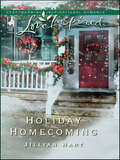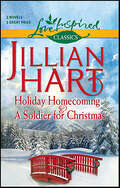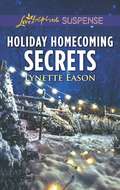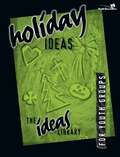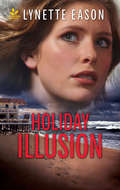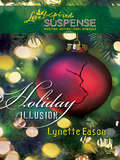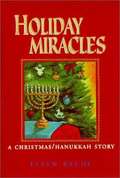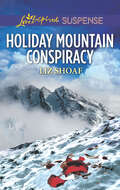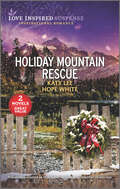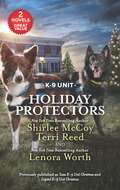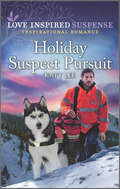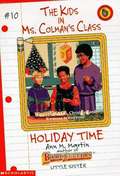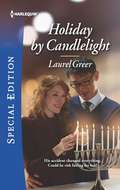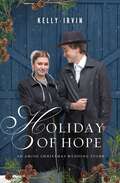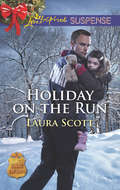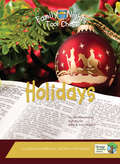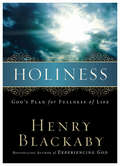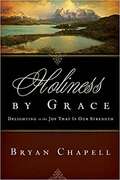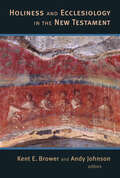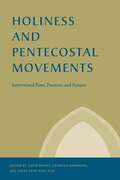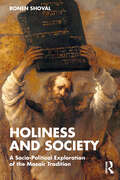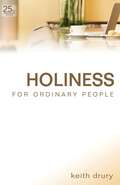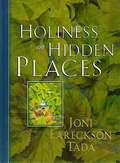- Table View
- List View
Holiday Homecoming
by Jillian HartKNIGHT IN A SHINING SUVShe was supposed to be home in Montana for Thanksgiving, but Kristin McKaslin was stranded at the Boise airport—in a snowstorm. There was no hope. Then, out of nowhere, a car pulled up. It was Ryan Sanders, the charming football player she'd barely known in high school. He was going home, too.Kristin's girl-next-door beauty had always stayed with Ryan, and she'd turned into an incredible woman. But he thought he loved another. So what was that hard knot doing in his gut when their all-night drive was over? Why didn't he want to see her go?Suddenly Ryan suspected the Lord might have more in mind than just a drive…
Holiday Homecoming & A Soldier for Christmas
by Jillian HartHoliday HomecomingWhen Kristin McKaslin finds herself snowbound for Thanksgiving, Ryan Sanders comes to her rescue. And as their paths cross again and again for each festive occasion, she starts to wonder. She came home for the holidays-would she be willing to stay for love?A Soldier for ChristmasIt's pure chance that has Mitch Dalton walking into Kelly Logan's shop. But when the soldier asks if he can write her, a correspondence courtship starts to thrive. After holiday leave brings Mitch home, he knows he can't leave again without Kelly's promise to be his Christmas bride.
Holiday Homecoming Secrets (Mills And Boon Love Inspired Suspense Ser.)
by Lynette EasonA man from her past is back—to help her solve a holiday murder case.A friend is missing and presumed dead, and detective Jade Hollis is determined to track down the killer. To do that she must team up with private investigator Bryce Kingsley—who doesn’t know he is the father of her child. But she’ll have to put personal secrets aside because the killer will strike again to keep the truth from being exposed.
Holiday Ideas (The Ideas Library)
by Youth SpecialtiesOver 200 festive ideas for cranking up celebrations for every holiday imaginable! - Christmas . . . Here's your one-stop Christmas programming center. You'll find everything you need for the merriest Advent and Christmas season ever -- goofy games, crazy carols, outrageous outings, and silly skits to fill even the biggest Christmas stocking. And, of course, Christmassy meetings and lessons to help your kids focus on the real reason for the season. - Easter & Lent . . . Worship activities, reenactments, Bible lessons, meeting plans, and service projects, all designed to commemorate the death and resurrection of Jesus Christ. Plus games, puzzles, craft projects, and scavenger hunt ideas -- all tied to an Easter theme. - Valentine's Day . . . Play a memorable February 14th with these icebreakers, games, songs, activities, and Bible lessons -- all about love, whether human or divine. - Thanksgiving . . . Wait until you see the potful of ideas that youth workers from Cape Cod to all points west have cooked up for you -- Thanksgiving craft projects, skits, outings, parties, service projects, and Bible lessons. Plus More . . . All kinds of party and meeting ideas for St. Patrick's Day, New Year's, Halloween, Super Bowl Sunday, April Fool's Day, Mother's and Father's Day celebrations, and graduation. Whether you're a youth worker or a recreation director in a church, school, club, or camp -- Holiday Ideas is your storehouse of proven, youth-group tested ideas.
Holiday Illusion
by Lynette EasonA timeless story of Christmas suspense by bestselling author Lynette EasonTo save a sick, orphaned boy, Anna Freeman must risk her own life. Little Paulo desperately needs a new heart. It’s his only Christmas wish—well, that and building his first snowman. For the surgery, Anna must take him to a hospital in the city she once called home. A place she fled in fear years ago. Which means telling Dr. Lucas Bennett that the woman he’s known all this time as a caring orphanage worker is really someone else. Someone with a very frightening past. And that the danger stalking all of them won’t take Christmas Day off.Book 3 in the Refuge from Danger series. Originally published in 2008.
Holiday Illusion (Amazon Adventure #3)
by Lynette EasonTo save a sick, orphaned boy, Anna Freeman must risk her own life. Little Paulo desperately needs a new heart. It's his only Christmas wish--well, that and building his first snowman. For the surgery, Anna must take him to a hospital in the city she once called home. A place she fled in fear years ago. Which means telling Dr. Lucas Bennett that the woman he's known all this time as a caring orphanage worker is really someone else. Someone with a very frightening past. And that the danger stalking all of them won't take Christmas Day off.
Holiday Miracles: A Christmas / Hannukah Story
by Ellyn BacheThe heartwarming story of a family where Dad is Christian and Mom is Jewish. During the December holidays, their son becomes seriously ill and their faith is tested.
Holiday Mountain Conspiracy (Mills And Boon Love Inspired Suspense Ser.)
by Liz ShoafA covert operative and a journalist join forces to uncover government intrigue in the mountains of Wyoming in this inspirational romantic suspense.After his last CIA assignment ended in betrayal, the covert operative known only as Ned holes up for Christmas in his remote mountain cabin, preparing to trap the men hunting him. But journalist Mary Grace Ramsey reaches Ned first, injured and determined to uncover why someone is after her and her CIA agent brother. Together, can they unravel a conspiracy that goes higher than they ever imagined?
Holiday Mountain Rescue
by Hope White Katy LeeHigh-stakes secrets heat up the season in two suspenseful novels from the author of the Roads to Danger series and the author of the Echo Mountain books.High Speed Holiday by Katy LeeAfter Ian Stone discovers he was kidnapped when he was a baby, he visits his “family’s” hometown—and is shot at. He’s convinced the Spencers don’t want their long-lost brother, Luke, to return and claim his inheritance. Chief of police Sylvie Laurent is skeptical of Ian’s story, but they’ll have to work together if they want to uncover the truth.Christmas Undercover by Hope WhiteFBI agent Sara Vaughn believes corrupt businessmen are engineering drugs with deadly results. Following the suspects into the Cascade Mountains, Sara witnesses them murder one of their own and she’s targeted. Saved by mountain rescue worker Will Rankin, Sara at first suspects he’s one of the bad guys. But when Will risks everything to save her, she knows that he’s all that’s standing between her and seeing Christmas morning.
Holiday Protectors: Her Holiday Protector Christmas Undercover The Marshal's Runaway Witness (Men Of Millbrook Lake Ser. #2)
by Lenora Worth Terri Reed Shirlee McCoyDANGER STRIKES AT CHRISTMASTIME Texas K-9 Unit Christmas by Shirlee McCoy and Terri ReedIn Holiday Hero by Shirlee McCoy, Emma Fairchild is attacked and left for dead in her own diner. Her childhood friend turned K-9 cop Lucas Harwood offers a chance at justice—and love. And in Rescuing Christmas by Terri Reed, a killer has set his sights on K-9 dog trainer Lily Anderson. When fellow officer Jarrod Evans appoints himself her bodyguard, Lily knows more than her life is at risk—so is her heart.Capitol K-9 Unit Christmas by Shirlee McCoy and Lenora WorthIn Protecting Virginia by Shirlee McCoy, a mysterious intruder wants foster care worker Virginia Johnson out of her house. It’s up to Capitol K-9 Unit officer John Forrester to keep her alive to see the New Year. And in Guarding Abigail by Lenora Worth, Capitol K-9 Unit officer Dylan Ralsey must keep Abigail Wheaton, a murdered diplomat’s daughter, safe from a killer who wants to ruin everyone’s holiday.
Holiday Secrets
by Susan SleemanDEADLY HOLIDAY REUNION When his ex is thrust into the crosshairs of a deadly syndicate, FBI agent Gavin McKade will do whatever it takes to protect her. Even work the case with his stubborn sheriff dad. Gavin’s holiday homecoming isn’t exactly warm and fuzzy, but he must set aside the past to make sure Lexie Grant survives. As if protecting Lexie from professional killers isn’t difficult enough, the unlikely reunion has rekindled their complicated romantic connection. But if Gavin can’t untangle Lexie from this dangerous web, the blurring line between duty and love may not matter…because this Christmas could be their last.
Holiday Suspect Pursuit
by Katy LeeUnraveling a murder mystery could unlock his lost memories… After a murderer strikes, former deputy Jett Butler and his search-and-rescue dog must work with the sole witness—FBI agent Nicole Harrington. But Nicole&’s the ex-fiancée he left behind after a car accident gave him amnesia years ago. And in a fight to survive the holidays, remembering his past might be just as dangerous as facing the killer on their heels…From Love Inspired Suspense: Courage. Danger. Faith.
Holiday Time (The Kids in Ms. Colman's Class #10)
by Ann M. MartinEveryone in the class is working together on holiday projects. But when a new student, Pamela, arrives, she comes between Sara and Audrey.
Holiday by Candlelight (Sutter Creek, Montana)
by Laurel GreerA tragic accident ended the life he once knewIs a Hanukkah miracle right around the corner?This year, Dr. Caleb Matsuda could do without holiday cheer. After an avalanche robbed him of his ability to practice surgery, he struggles to make it through each day. He may be intrigued by new colleague Garnet James, but she’s also a search-and-rescue volunteer who could be in danger at any moment. If only she wasn’t perfect for the man he used to be…
Holiday of Hope: An Amish Christmas Wedding Story
by Kelly IrvinAn Amish Christmas Wedding story from bestselling author Kelly Irvin.Henry Lufkin is one of four bachelors who lived in the West Kootenai, Montana, cabins that were destroyed by wildfires. He&’s the only one of them who hasn&’t since married, but he likes his solitude. Then an old friend asks him to care for his son, and Henry has to share his small cabin and his life with bewildered and rebellious ten-year-old Tommy. When the child encounters trouble at school, Henry reaches out to Tommy&’s teacher. Leesa Yoder never expected to find herself single and teaching sixteen young scholars, and she certainly didn&’t anticipate an inexperienced bachelor telling her how to do her job. Amid the flying sparks, can Henry and Leesa see that there might be hope and love in this unexpected situation?
Holiday on the Run
by Laura ScottWOMAN IN HIDING After witnessing a murder, Melissa Harris faked her death, changed her name and went into hiding, hoping to keep the gunmen at bay. For years, it worked-but now the ruthless killers have found her. When bullets begin to fly, SWAT cop Nate Freemont rescues Melissa and her little girl. Her former high school sweetheart is shocked that she's alive and seeks an explanation about why she vanished from his life. Telling the truth would only put her daughter's safety and Nate's future in jeopardy. With Christmas approaching, can Melissa risk everything to accept the safe haven and second chance Nate offers...as deadly enemies close in? SWAT: Top Cops-Love in the line of duty
Holidays
by Kurt BrunerThis book contains complete plans for helping kids learn spiritual truths from eight traditional holidays, plus it helps them appreciate the sanctity of Human Life.
Holiness
by Henry Blackaby"If there is anything that characterizes God's people in America today, it is the loss of the fear of God," states Henry Blackaby. When you do not fear God, he contends, you will not fear sin. The troubling result of this issue is that many Christians fail to recognize that they have sinned against God. The lack of holiness within the Church has reached epidemic levels. "True revival can only come," notes Blackaby, "when the people of God return to a healthy, holy fear of Him." God, in His holiness, is grieved by our lack of it. In this worthy book, Blackaby urges believers to look inward, to see sin from God's perspective, and to live to the standard that He has set in Scripture. He writes, "The salvation of the nation has little to do with Washington or Hollywood-it has to do with the people of God!" As referenced in 2 Chronicles 7:14, Blackaby notes that the redemption of America lies in the repentance of the people of God. He challenges readers by adding, "If America depended on your prayer life, would there be revival?" Revival waits on the holiness of His people; this book provides the path that will lead us back.
Holiness By Grace: Delighting In The Joy That Is Our Strength
by Bryan Chapell“Be holy, for I am holy.” Without Christ we would hear this command and shudder. How can God expect us to be holy as he is? But thanks to what Christ has accomplished on our behalf, God accepts us because of his Son’s righteousness. Yet the call to holiness remains. In this redesigned edition of his book, preacher and teacher Bryan Chapell puts good works and obedience in proper perspective. He traces the relationship of holiness and grace in three parts, outlining the principles of grace, the practices of faith, and the motives of love. This book will challenge readers to discover the gracious source of joy and strength they will need for a lifelong pursuit of holiness.
Holiness and Ecclesiology in the New Testament
by Andy Johnson, Kent BrowerThroughout the biblical story, the people of God are expected to embody God's holy character publicly. Therefore, holiness is a theological and ecclesial issue prior to being a matter of individual piety. Holiness and Ecclesiology in the New Testament offers serious engagement with a variety of New Testament and Qumran documents in order to stimulate churches to imagine anew what it might mean to be a publicly identifiable people who embody God's very character in their particular social setting.Contributors: J. Ayodeji Adewuya Paul M. Bassett Richard Bauckham George J. Brooke Kent E. Brower Dean Flemming Michael J. Gorman Joel B. Green Donald A. Hagner Andy Johnson George Lyons I. Howard Marshall Troy W. Martin Peter Oakes Ruth Anne Reese Dwight Swanson Gordon J. Thomas Richard P. Thompson J. Ross Wagner Robert W. Wall Bruce W. Winter
Holiness and Pentecostal Movements: Intertwined Pasts, Presents, and Futures (Studies in the Holiness and Pentecostal Movements #1)
by David Bundy, Geordan Hammond, and David Sang-Ehil HanSince the 1830s, Holiness and Pentecostal movements have had a significant influence on many Christian churches, and they have been a central force in producing what is known today as World Christianity. This book demonstrates the advantages of analyzing them in relation to one another.The Salvation Army, the Church of the Nazarene, the Wesleyan Church, and the Free Methodist Church identify strongly with the Holiness Movement. The Assemblies of God and the Pentecostal Assemblies of the World identify just as strongly with the Pentecostal Movement. Complicating matters, denominations such as the Church of God (Cleveland), the International Holiness Pentecostal Church, and the Church of God in Christ have harmonized Holiness and Pentecostalism. This book, the first in the new series Studies in the Holiness and Pentecostal Movements, examines these complex relationships in a multidisciplinary fashion. Building on previous scholarship, the contributors provide new ways of understanding the relationships, influences, and circulation of ideas among these movements in the United States, the United Kingdom, India, and Southeast and East Asia.In addition to the editors, the contributors are Kimberly Ervin Alexander, Insik Choi, Robert A. Danielson, Chris E. W. Green, Henry H. Knight III, Frank D. Macchia, Luther Oconer, Cheryl J. Sanders, and Daniel Woods.
Holiness and Pentecostal Movements: Intertwined Pasts, Presents, and Futures (Studies in the Holiness and Pentecostal Movements)
by David Bundy, Geordan Hammond, and David Sang-Ehil HanSince the 1830s, Holiness and Pentecostal movements have had a significant influence on many Christian churches, and they have been a central force in producing what is known today as World Christianity. This book demonstrates the advantages of analyzing them in relation to one another.The Salvation Army, the Church of the Nazarene, the Wesleyan Church, and the Free Methodist Church identify strongly with the Holiness Movement. The Assemblies of God and the Pentecostal Assemblies of the World identify just as strongly with the Pentecostal Movement. Complicating matters, denominations such as the Church of God (Cleveland), the International Holiness Pentecostal Church, and the Church of God in Christ have harmonized Holiness and Pentecostalism. This book, the first in the new series Studies in the Holiness and Pentecostal Movements, examines these complex relationships in a multidisciplinary fashion. Building on previous scholarship, the contributors provide new ways of understanding the relationships, influences, and circulation of ideas among these movements in the United States, the United Kingdom, India, and Southeast and East Asia.In addition to the editors, the contributors are Kimberly Ervin Alexander, Insik Choi, Robert A. Danielson, Chris E. W. Green, Henry H. Knight III, Frank D. Macchia, Luther Oconer, Cheryl J. Sanders, and Daniel Woods.
Holiness and Society: A Socio-Political Exploration of the Mosaic Tradition
by Ronen ShovalExploring the subtle political philosophy within the Biblical narrative, this book presents enduring insights that complement Ancient Greek philosophy for contemporary political distinctions – uncovering overlooked socio-political ideologies to provide a unique perspective alongside the classical philosophical tradition.By adopting a sociological approach, Ronen Shovel interprets the Bible as a reflection of perspectives and ideologies, emphasizing the intricate dynamics between rulers and subjects, balancing justice, and power within societies. A key focus is the examination of holiness as a distinct political category, influencing institutions, ethics, justice, and even the use of force. This perspective challenges traditional religious scholarship, merging sociology with the concept of holiness.Holiness and Society enriches political philosophy, religious studies, and sociology, broadening their boundaries and offering fresh perspectives, serving as a bridge between antiquity and modernity, providing valuable insights into contemporary political thought.
Holiness for Ordinary People
by Keith DruryHoliness is not a special category, reserved only for a few select Christians. God intends for every Christian to live a holy life! In simple, practical terms, master teacher Keith Drury explains how every Christian can live a Christ-like life. He presents clear biblical insights and deals candidly with the obstacles that confront Christians in their everyday lives. Holiness for Ordinary People will inspire you to become the person God intends you to be.
Holiness in Hidden Places
by Joni Eareckson TadaThrough a series of devotions, Joni helps us to focus on the every day situations that show us "Holiness in Hidden Places."
